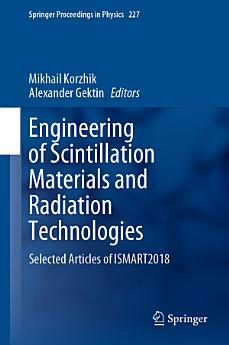Engineering of Scintillation Materials and Radiation Technologies: Selected Articles of ISMART2018
Mikhail Korzhik · Alexander Gektin
Sep 2019 · Springer Proceedings in Physics Book 227 · Springer Nature
Ebook
326
Pages
reportRatings and reviews aren’t verified Learn More
About this ebook
This proceedings book presents dual approaches to examining new theoretical models and their applicability in the search for new scintillation materials and, ultimately, the development of industrial technologies. The ISMART conferences bring together the radiation detector community, from fundamental research scientists to applied physics experts, engineers, and experts on the implementation of advanced solutions. This scientific forum builds a bridge between the different parts of the community and is the basis for multidisciplinary, cooperative research and development efforts. The main goals of the conference series are to review the latest results in scintillator development, from theory to applications, and to arrive at a deeper understanding of fundamental processes, as well as to discover components for the production of new generations of scintillation materials. The book highlights recent findings and hypotheses, key advances, as well as exotic detector designs and solutions, and includes papers on the microtheory of scintillation and the initial phase of luminescence development, applications of the various materials, as well as the development and characterization of ionizing radiation detection equipment. It also touches on the increased demand for cryogenic scintillators, the renaissance of garnet materials for scintillator applications, nano-structuring in scintillator development, trends in and applications for security, and exploration of hydrocarbons and ecological monitoring.
About the author
Mikhail Korzhik (Korjik) received his diploma in Physics at the Belarus State University in 1981. He got his PhD in 1991 and Doctoral Diploma in 2005 in Nuclear Physics and Optics. Since the beginning of nineties he was deeply involved in research and development of inorganic scintillation materials. He was instrumental in the development of the YAlO3:Ce technology for low energy gamma-rays detection. An important achievement has been the discovery of Pr3+ doped scintillation media and GdAlO3:Ce and LuAlO3:Ce scintillation materials. His study promoted the understanding of scintillation mechanism in many crystals. He took part in the discovery and mass production technology development of the lead tungstate PbWO4 scintillation crystal for high energy physics application, which resulted in the use of this crystal in two ambitious experiments at LHC, CMS and ALICE and an important contribution to the discovery of the Higgs boson. He is member of the Scientific Advisory Committee of the SCINT cycle of International Conferences dedicated to scintillation materials development.
Alexander Gektin received his diploma after graduating at the Physical faculty of Kharkov university. His PhD thesis (1981) was devoted to defects study in halide crystals. He got his DrSci degree in 1990 (Riga, Latvia) when he investigated the influence of high irradiation doses to crystals. During the last two decades he took part as a renowned scintillation material scientist to several international projects like BELLE, BaBar, PiBeta, CMS in high energy physics, GLAST and AGILLE in astrophysics. At the same time he has led several developments for medical imaging (large area SPECT scintillator) and security systems (600 mm long position sensitive detectors).The major part of these technology developments was transferred to different industrial production lines. At the same time he is known as an expert in the study of fundamental processes of energy absorption, relaxation and light emission in scintillation materials. He has authored more then 250 publications. He is also an Associated Editor of IEEE Transaction of Nuclear Sciences.
Alexander Gektin received his diploma after graduating at the Physical faculty of Kharkov university. His PhD thesis (1981) was devoted to defects study in halide crystals. He got his DrSci degree in 1990 (Riga, Latvia) when he investigated the influence of high irradiation doses to crystals. During the last two decades he took part as a renowned scintillation material scientist to several international projects like BELLE, BaBar, PiBeta, CMS in high energy physics, GLAST and AGILLE in astrophysics. At the same time he has led several developments for medical imaging (large area SPECT scintillator) and security systems (600 mm long position sensitive detectors).The major part of these technology developments was transferred to different industrial production lines. At the same time he is known as an expert in the study of fundamental processes of energy absorption, relaxation and light emission in scintillation materials. He has authored more then 250 publications. He is also an Associated Editor of IEEE Transaction of Nuclear Sciences.
Rate this ebook
Tell us what you think.
Reading information
Smartphones and tablets
Install the Google Play Books app for Android and iPad/iPhone. It syncs automatically with your account and allows you to read online or offline wherever you are.
Laptops and computers
You can listen to audiobooks purchased on Google Play using your computer's web browser.
eReaders and other devices
To read on e-ink devices like Kobo eReaders, you'll need to download a file and transfer it to your device. Follow the detailed Help Center instructions to transfer the files to supported eReaders.








